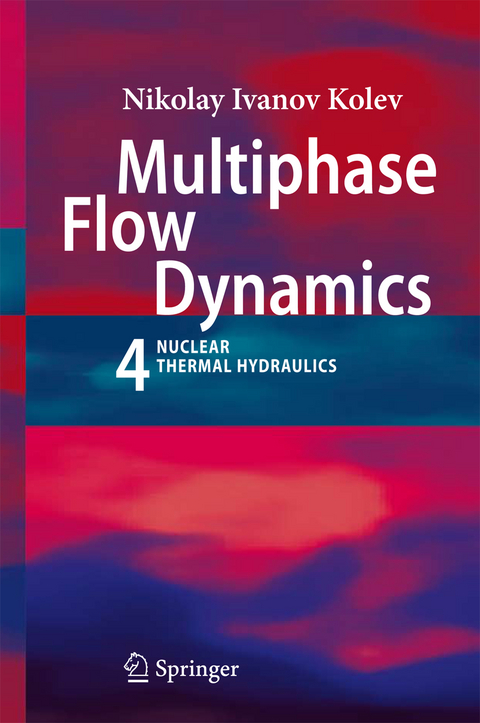
Multiphase Flow Dynamics 4
Nuclear Thermal Hydraulics
Seiten
2010
|
Softcover reprint of hardcover 1st ed. 2009
Springer Berlin (Verlag)
978-3-642-10093-2 (ISBN)
Springer Berlin (Verlag)
978-3-642-10093-2 (ISBN)
This is Volume 4 of the successful book package "Multiphase Flow," and it is devoted to the theory and applications of multiphase flow dynamics to nuclear thermal hydraulics.
The nuclear thermal hydraulic is the science providing knowledge about the physical processes occurring during the transferring the fission heat released in structural materials due to nuclear reactions into its environment. Along its way to the environment the thermal energy is organized to provide useful mechanical work or useful heat or both. Chapter 1 contains introductory information about the heat release in the re- tor core, the thermal power and thermal power density in the fuel, structures and moderator, the influence of the thermal power density on the coolant temperature, the spatial distribution of the thermal power density. Finally some measures are introduced for equalizing of the spatial distribution of the thermal power density. Chapter 2 gives the methods for describing of the steady and of the transient temperature fields in the fuel elements. Some information is provided regarding influence of the cladding oxidation, hydrogen diffusion and of the corrosion pr- uct deposition on the temperature fields. Didactically the nuclear thermal hydraulic needs introductions at different level of complexity by introducing step by step the new features after the previous are clearly presented. The followed two Chapters serve this purpose. Chapter 3 describes mathematically the "simple" steady boiling flow in a pipe. The steady mass-, momentum- and energy conservation equations are solved at different level of complexity by removing one after the other simplifying assu- tions. First the idea of mechanical and thermodynamic equilibrium is introduced.
The nuclear thermal hydraulic is the science providing knowledge about the physical processes occurring during the transferring the fission heat released in structural materials due to nuclear reactions into its environment. Along its way to the environment the thermal energy is organized to provide useful mechanical work or useful heat or both. Chapter 1 contains introductory information about the heat release in the re- tor core, the thermal power and thermal power density in the fuel, structures and moderator, the influence of the thermal power density on the coolant temperature, the spatial distribution of the thermal power density. Finally some measures are introduced for equalizing of the spatial distribution of the thermal power density. Chapter 2 gives the methods for describing of the steady and of the transient temperature fields in the fuel elements. Some information is provided regarding influence of the cladding oxidation, hydrogen diffusion and of the corrosion pr- uct deposition on the temperature fields. Didactically the nuclear thermal hydraulic needs introductions at different level of complexity by introducing step by step the new features after the previous are clearly presented. The followed two Chapters serve this purpose. Chapter 3 describes mathematically the "simple" steady boiling flow in a pipe. The steady mass-, momentum- and energy conservation equations are solved at different level of complexity by removing one after the other simplifying assu- tions. First the idea of mechanical and thermodynamic equilibrium is introduced.
Heat release in the reactor core.- Temperature inside the fuel elements.- The "simple" steady boiling flow in a pipe.- The "simple" steady three-fluid boiling flow in a pipe.- Core thermal hydraulic.- Flow boiling and condensation stability analysis.- Critical multiphase flow.- Steam generators.- Moisture separation.- Pipe networks.- Some auxiliary systems.- Emergency condensers.- Core degradation.- Melt-water interaction.- Coolability of layers of molten reactor material.- External cooling of reactor vessels during severe accident.- Thermo-physical properties for severe accident analysis.
From the reviews:
"The work by Kolev presents a very careful and detailed introduction to the methodology of nuclear thermal hydraulics providing knowledge and mathematical tools for adequate description of processes in materials due to nuclear reactions. ... well written and readable, and contains a lot of original and excellently prepared figures in color form. Results of numerical solutions are given graphically and in tabular form. ... will be of interest to a wide range of specialists working in the area of multiphase flow dynamics and heat transfer." (Ioan Pop, Zentralblatt MATH, Vol. 1175, 2010)| Erscheint lt. Verlag | 24.12.2010 |
|---|---|
| Zusatzinfo | XXXII, 745 p. 378 illus. |
| Verlagsort | Berlin |
| Sprache | englisch |
| Maße | 155 x 235 mm |
| Gewicht | 2370 g |
| Themenwelt | Informatik ► Theorie / Studium ► Künstliche Intelligenz / Robotik |
| Naturwissenschaften ► Physik / Astronomie ► Mechanik | |
| Naturwissenschaften ► Physik / Astronomie ► Strömungsmechanik | |
| Naturwissenschaften ► Physik / Astronomie ► Thermodynamik | |
| Technik ► Elektrotechnik / Energietechnik | |
| Technik ► Maschinenbau | |
| Schlagworte | Dynamics • fluid- and aerodynamics • Knowledge • Multiphase dynamics • Multiphase Fflow • Multiphase Flow • Nuclear Engineering • Nuclear Thermal-Hydraulics • Reactor Engineering • Turbulence • Uncertainty |
| ISBN-10 | 3-642-10093-7 / 3642100937 |
| ISBN-13 | 978-3-642-10093-2 / 9783642100932 |
| Zustand | Neuware |
| Informationen gemäß Produktsicherheitsverordnung (GPSR) | |
| Haben Sie eine Frage zum Produkt? |
Mehr entdecken
aus dem Bereich
aus dem Bereich
Eine kurze Geschichte der Informationsnetzwerke von der Steinzeit bis …
Buch | Hardcover (2024)
Penguin (Verlag)
28,00 €
Buch | Softcover (2024)
REDLINE (Verlag)
20,00 €


